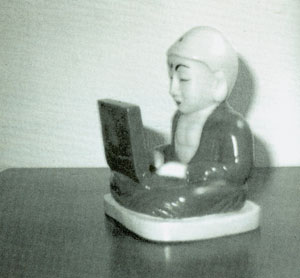
In the garden outside Wat Buaniwet, Thailand’s most important Buddhist temple, Abhinito, a young monk, sat with me under the shade of a large tropical plant. Together, we discussed Abhinito’s emigration from Indonesia to Thailand, the horrific Bangkok traffic, and other topics. But after thirty minutes, Abhinito appeared distracted. “I’m sorry,” he apologized, “but I have to go update my website.”
Abhinito is hardly the only Southeast Asian monk venturing online. Fearing that Buddhism is becoming irrelevant in the garden outside Wat Buaniwet, Thailand’s most important Buddhist temple, Abhinito, a young monk, sat with me under the shade of a large tropical plant. Together, we discussed Abhinito’s emigration from Indonesia to Thailand, the horrific Bangkok traffic, and other topics. But after thirty minutes, Abhinito appeared distracted. “I’m sorry,” he apologized, “but I have to go update my website.”
Abhinito is hardly the only Southeast Asian monk venturing online. Fearing that Buddhism is becoming irrelevant to young Southeast Asians, monks as well as laypeople in the region have begun utilizing the Internet to spread the Buddha’s teachings. Yet as these groundbreakers embrace the new technology, they are stirring controversy about whether or not the Internet is a suitable spiritual medium.
From virtually no online presence five years ago, Southeast Asia’s Buddhists have recently exploded onto the Web. The number of Buddhist websites in the region has more than quadrupled since 1996, and in Thailand, where 95 percent of the country’s sixty million people are Buddhist, there are now over one hundred Thai-language sites focusing on the dharma. Popular monks in Thailand have set up personal homepages in order to connect with their followers, answer questions, and organize retreats. Buddhist temples in Singapore and Taiwan host extensive web pages and send out daily e-mails reminding followers of dharma lessons. Farther north, South Korean monks work as DJs on local Internet radio stations.
For many Southeast Asian Buddhists, this foray online has been timed exquisitely. “Recently, we have seen that young people are losing interest in Buddhism, since they have so many distractions,” Abhinito says. “But the Internet will help get them involved again.” Indeed, Southeast Asian Buddhism faces a serious quandary. Monks in the region point out that the number of men entering the Buddhist clergy for the traditional three-month period during adolescence has dropped precipitously in recent years—a decline that is due in part to public dismay over a series of financial and sex scandals involving Buddhist clergy.
But economic development, with its attendant materialism, plays a role as well. Today many young Thais, raised during the country’s secular-minded economic boom in the 1990s, are primarily interested in making money and increasingly feel that religion has little impact on their lives. Advocates of online dharma contend that websites allow people to personalize religion, as Web users can pick and choose those tenets of Buddhism most relevant to their lives. This prospect is particularly attractive to young Southeast Asians, who favor individual learning and personal insight over adherence to rituals, which they regard as archaic and superstitious. The Internet, by offering excerpts and translations, makes it easier to access Buddhist teachings than by wading through hundreds of books.
Luenchay Vongvanij, head of the Bangkok-based Buddhist website www.dhammathai.org, has argued that the Web can simplify complex religious texts and allow Southeast Asians to tailor Buddhism to their current lifestyles without ever having to leave their homes. This and similar websites address such current topics as the role of monks in a modern society, Buddhism’s views on abortion, and the role of women in the region’s Buddhist clergy.
Meanwhile, progressive religious leaders believe the Internet will force Southeast Asia’s aging clergy to reform, a prerequisite for removing the stain of scandal. “Moving onto the Web will undermine religion’s power structure, since average people will have better access to Buddha’s teachings,” Alan Lopez, a Buddhism scholar, told me during a forum at the World Fellowship of Buddhists, a leading Bangkok organization. As lay people become more knowledgeable, the monastic hierarchy will be unable to monopolize the religion, Lopez said, because regular citizens will be better informed and more inclined to question monks.
Buddhism on the Web appears to have made some inroads with younger people. Recent forums held at the World Fellowship of Buddhists, which advertises online, have drawn sizable numbers of young adults. Webmasters report a steady increase in hits to Buddhist-related sites, although it is impossible to determine the age of these new visitors.
Still, not everyone in Southeast Asia is comfortable with online Buddhism. Traditionalists charge that the Web provides Southeast Asians with an oversimplified version of the religion, thereby preventing them from confronting Buddhism’s complexities. What is more, skeptics contend, the availability of Buddhist teachings on the Internet could lead to a decrease in temple visits and thus force many religious organizations to close down for lack of funding. This is not an irrational fear: in the United States, polls have predicted that by 2010, between 15 and 20 percent of Christians will have stopped attending churches and will rely solely on the Internet for their spiritual needs.
As the region’s elderly religious leaders pass away, a new generation of monks like Abhinito—clergy comfortable with the Web who could use the Internet to raise money for temples, among other things—will come to power. But even the most ardent advocates of Buddhism on the Internet don’t believe it will replace person-to-person contact with monks entirely in Southeast Asia. Through websites, they hope, people can learn about Buddhist concepts and determine which school or teacher feels like the right fit; they can then pursue further study in person. Whatever the outcome, there will be a vast testing ground in the coming decade: within ten years, Internet research firms predict, Southeast Asia will have the most citizens online of any region in the world. ▼
Thank you for subscribing to Tricycle! As a nonprofit, we depend on readers like you to keep Buddhist teachings and practices widely available.